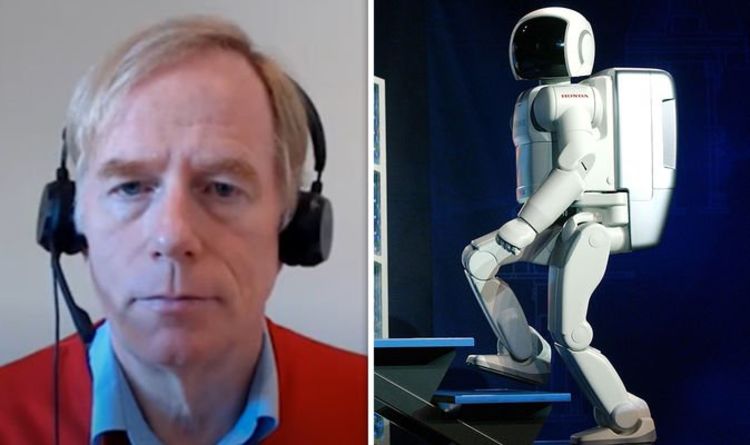THERE’S a 50 percent chance robots will be capable of completing “all human tasks” by 2050, allowing humans to move to a post-compulsory work society, according to a leading transhumanist thinker.


I just watched an interesting series of videos on YouTube that I’d like to recommend. It is an introductory level series of very short videos on the topic of transhumanism. They are in French with subtitles. Guillaume Loublier created these to spread the word of Transhumanism throughout France. There are four videos, and if you start with the first one, then they all play in sequence automatically.
Watch them and let Guillaume know what you think of his work.
Version anglophone traduite par Julia VALETTE
https://www.linkedin.com/in/julia-valette-742993172/
Du programme Tolérance Augmentée réalisé par Laura CHARPENTIER, conçu, écrit & interprété par Guillaume LOUBLIER.
Who am I? Le transhumanisme!
TABLE OF CONTENTS —————
:00–15:11 : Introduction
:11–36:12 CHAPTER 1: POSTHUMANISM
a. Neurotechnology b. Neurophilosophy c. Teilhard de Chardin and the Noosphere.
—————————————————————————————–
POSTHUMAN TECHNOLOGY
—————————————————————————————–
:12–54:39 CHAPTER 2 : TELEPATHY/ MIND-READING
a. MRI
b. fMRI
c. EEG
d. Cognitive Liberty e. Dream-recording, Dream-economies f. Social Credit Systems g. Libertism VS Determinism.
:02:07–1:25:48 : CHAPTER 3 : MEMORY/ MIND-AUGMENTING
a. Memory Erasure and Neuroplasticity b. Longterm Potentiation (LTP/LTD)
c. Propanolol d. Optogenetics e. Neuromodulation f. Memory-hacking g. Postmodern Dystopias h. Total Recall, the Matrix, and Eternal Sunshine of the Spotless Mind i. Custom reality and identity.
:25:48–1:45:14 CHAPTER 4 : BCI/ MIND-UPGRADING
a. Bryan Johnson and Kernel b. Mark Zuckerberg and Neuroprosthetics c. Elon Musk, Neural Lace, and Neuralink d. Neurohacking, Neuroadvertizing, Neurodialectics e. Cyborgs, Surrogates, and Telerobotics f. Terminator, Superintelligence, and Merging with AI
g. Digital Analogs, Suffering, and Virtual Drugs h. Neurogaming and “Nervana” (technological-enlightenment)
:45:14 −2:02:57 CHAPTER 5 : CONNECTOME/ MIND-MAPPING
Gerd Leonhard discussion regarding Humanism and Transhumanism.
This is an excerpt from my latest digital conference, April 23, 2020, “Humanist vs Transhumanist” featuring Calum Chace and me.
My Futures Agency colleague and fellow futurist Calum Chace disagree with me on many of my core messages on topics such as the singularity, (trans)-humanism, artificial intelligence and what I call ‘man+machine futures’.
Here’s the new IMMORTALITY OR BUST 2-min highlight video. The feature documentary will air on Amazon Prime/Video on June 23rd! Four years in the making, the award-winning film features celebrities, scientists & transhumanism activists along my Immortality Bus road trip. https://www.facebook.com/ZoltanGIstvan/videos/1497742500404615/ #ImmortalityOrBust
CHECK OUT SEASON 1 PLAYLIST: https://www.youtube.com/watch?v=ic9AV4mMbOQ&list=PL_GIV9cvJ8…itbMC34bPF
KEEP THE SHOW ON-AIR! : WWW.PATREON.COM/DEBTNATION
• PLEASE CHECK OUR SPONSOR: WWW.IAMTRANSHUMAN.ORG/
• LINK TO BOOK: https://www.amazon.com/Transhumanism-Handbook-Newton-Lee/dp/…atfound-20
IN THIS EPISODE:
•
…
This episode of Debt Nation is sponsored by Thrivous, the human enhancement company (https://thrivous.com). Thrivous develops and distributes advanced nootropic and geroprotector dietary supplements, to enhance cognition and promote healthy aging. Each nutrient and each dose is based on multiple human studies. And all quality control is completely open source.
The ‘bionic’ girl who doesn’t eat, rarely sleeps and didn’t even feel pain.
Meet 7-year-old Ethan, who received his bionic Hero Arm yesterday at the Hanger Clinic in Aurora, Illinois. Ethan contracted sepsis shortly after his second birthday and he was given a five per cent chance of survival, but the superhero in him fought and survived. Stay strong, Ethan, and may the Force be with you! ✨ 😍 💪 #EthanStrong

For transhumanists, the possibilities of human interconnectivity via technology is only the beginning of how people may eventually transcend the limitations of their bodies. Photographer David Vintiner and art director Gem Fletcher set out to meet the innovators, artists, and dreamers within the transhumanism movement who are pushing the boundaries of their biology to become something more than human. Their project I Want to Believe consists of three chapters — the first touching on wearable technology, the second on individuals who have made permanent changes to their bodies, and the last on how some transhumanists plan to transcend the human condition.
“Science and human advancement has always been propelled forward by the people who do things differently and those who are not afraid to break the rules.”
An interview I did on my transhumanist focused channel with Robert Zubrin, head of the Mars society, about the case for human space colonisation, his work with Elon Musk and how becoming a multi-planet species will affect human civilisation. Very grateful for any subscriptions!
I interview Robert Zubrin, founder of The Mars Society and author of ‘The Case for Mars’ and ‘The Case for Space’ on human exploration and colonisation of Mars, the likely role played by private enterprise (SpaceX etr) vs national programmes and what a future Mars settlement could look like.